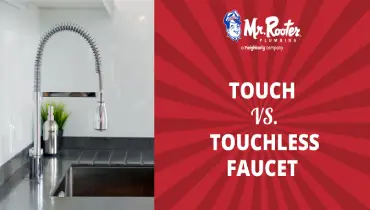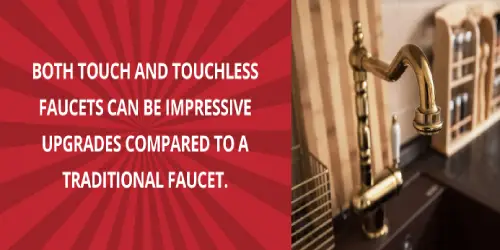Table of Contents:
- What Is the Difference Between a Touch and Touchless Faucet?
- How Do Touch-Sensitive Faucets Work?
- Pros and Cons of a Touch Faucet
- How Do Touchless Faucets Work?
- Pros and Cons of a Touchless Faucet
- Choosing the Right Faucet for Your Application
- Faucet Installations From Mr. Rooter of Syracuse

There are many types of kitchen sinks and faucets to consider when you are upgrading your kitchen, so you may overlook less common options like touch and touchless faucets. Touch and touchless faucets are more than just neat or novelty kitchen gadgets. They can make using the sink more convenient, can help you conserve water and can help you keep your kitchen clean and germ-free.
If you are looking to upgrade your standard kitchen faucet, both touch and touchless faucets are great options to consider, but you may find that one is a better fit for what you're looking for.
What Is the Difference Between a Touch and Touchless Faucet?
Touch and touchless faucets may sound like opposites, but they are actually quite similar. Both types of faucets are innovative versions of the traditional kitchen faucet. Unlike a traditional faucet, which requires a person to pull or push a handle, touch and touchless faucets minimize the action required to turn the tap on and off. The difference between the two is that a touch-sensitive kitchen faucet responds to physical touch, while a touchless faucet detects the presence of something in front of it.
How Do Touch-Sensitive Faucets Work?
How can a kitchen faucet turn on and off with a single touch? The answer comes down to electricity. Whenever you shock someone by touching them in the winter, it is a reminder that our bodies have the capacity to store electrical energy, known as capacitance. A touch-sensitive faucet also maintains an electrical charge and is equipped with a sensor that picks up on an increase in that charge when you touch it.
These sensors are even sophisticated enough to tell the difference in a single touch and a more prolonged grab that might occur when you're moving the faucet or cleaning it. The sensor is designed to only turn on and off with a single touch and shouldn't react at all to a longer grab.
Pros and Cons of a Touch Sink Faucet
There are some valuable benefits of touch-sensitive kitchen faucets, including:
- Water conservation: There are two reasons to want to use less water in your home. First, it saves you money. As water becomes increasingly scarce in many metropolitan areas, it’s also becoming more expensive. Wouldn't you want to decrease your water bill if you could? A touch-sensitive sink faucet is a great way to do that. And, secondly, saving water is important for the environment. As mentioned, water is scarce in some places around the world. The more we have of it, the better off we are.

- Cleanliness: Sink faucets can become gross, grimy places. Why? Because when we go to wash our hands, we typically must use our dirty hands to turn on the water. That’s not a problem with a touch-sensitive faucet. You don’t have to touch anything at all, allowing you to wash your hands without spreading germs and grime around your kitchen.
- Convenience: Perhaps the best part of a touch-sensitive faucet is how easy it is to use. It’s simple to turn on and off, and it’s easy to avoid any scalding temperatures that sometimes occur with a more traditional sink, too. If you have young children or seniors living with you, touch-sensitive faucets are often far easier for them to manipulate, as well.
There aren't many cons to a touch faucet. Some homeowners do not consider them because they cost more than traditional sink faucets. However, they can save you money over time by reducing water usage since they have automatic faucet shut-off. Installation is more involved with these faucets than standard faucets, though, so you will want to depend on professional help. If you use electrical power to run the faucet, you may see an increase in your energy usage. But you can also opt for battery power.
How Do Touchless Faucets Work?
Like touch faucets, touchless faucets — also called touch-free faucets — use sensors. These sensors are not designed to detect physical touch. Instead, they sense the presence of your hand or something else in front of the faucet. Most hands free faucets do this with an infrared detector paired with an infrared light. When your hand moves in front of the sensor, the infrared light bounces off of your hand and into the detector.
That means all you have to do to turn the faucet on and off is to move your hand in front of the faucet. There are other types of sensors on the market, too, such as ultrasonic field sensors. With these sensors, your hand moving in front of the sensor disrupts the field, signaling the faucet to turn on or off.
Pros and Cons of a Touchless Sink Faucet
Now, let's talk about the pros and cons of touchless kitchen sink faucets. You will notice these pros closely mirror those of touch faucets:
- Water conservation: Touchless faucets are designed to have a low flow rate and to prevent leakage. This means you can save a considerable amount of water compared to standard sink faucets. As we mentioned with touch-sensitive faucets, conserving water is both environmentally responsible and financially beneficial for homeowners.
- Hygiene: Cleanliness is a benefit of both touch and touchless faucets, but touchless faucets are the only faucet model that is completely touch-free. This means you can avoid messes and the spread of germs entirely. A simple wave of the hand will operate the faucet. This is the main advantage that touchless faucets have over touch faucets.
- Convenience: Like touch faucets, touchless faucets are also convenient to operate. They are great for people who may have trouble reaching or manipulating a traditional faucet. Especially when it comes to children, touchless faucets are the easiest to use since they don't even need to be able to reach the faucet to touch it as they would with a touch-sensitive model.
Like touch faucets, touchless faucets also tend to cost more than traditional faucets. Another downside is that, since this faucet uses electric power, a power outage means you won't be able to use your faucet's sensor. This is not an issue if you use batteries to power your faucet. The other issue you may run into with touch-free faucets is accidental activation. You may be moving dishes, for example, and turn the faucet on unintentionally. Pets can also turn the faucet on if they climb over the sink.
Choosing the Right Faucet for Your Application

Both touch and touchless faucets can be impressive upgrades compared to a traditional faucet. Both options exist because people have different preferences on which is best. People who find they are frequently turning on their kitchen sink with dough, raw meat or other food on their hands may want a completely touchless experience. The same may be true for people who get their hands dirty with other tasks like gardening or pottery. When you want water on-demand with no mess, touchless faucets are the ideal choice.
Some people prefer a touch faucet because it offers more control to the user. It is less likely to accidentally turn the faucet on or off when you have to physically touch as opposed to make a motion in front of it. Since you can activate these faucets by touching them with a wrist or elbow, you can usually still avoid transferring the mess on your hands onto the faucet.
Faucet Installations From Mr. Rooter of Syracuse
Are you ready to discover the benefits of a touch-sensitive or touchless faucet? It is best to get professional installation anytime you are investing in an important appliance or product like an upgraded faucet. At Mr. Rooter of Syracuse, we have the experience and knowledge needed for expert installation of these faucets. Call us for advice on which faucet to purchase or to schedule an installation. We can help you start enjoying the benefits of a touch or touchless faucet in your home.

